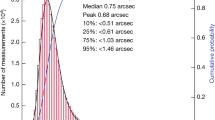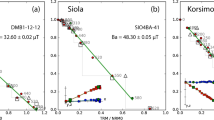Abstract
DURING the winter of 1932–33, a number of measurements of the height of the aurora borealis were made at Saskatoon (lat. 52° 07 53 N., long. 106° 37 47 W.). It was found that the height at which the lower limits of the auroral arcs and bands were most frequently seen was 105 km., a value in close agreement with that found by Størmer and others in Norway. Fig. 1 shows the distribution curve, the number of auroral points measured being plotted against their height in kilometres. In plotting this curve, 220 points were used and they were taken in 5 km. groups.
This is a preview of subscription content, access via your institution
Access options
Subscribe to this journal
Receive 51 print issues and online access
$199.00 per year
only $3.90 per issue
Buy this article
- Purchase on Springer Link
- Instant access to full article PDF
Prices may be subject to local taxes which are calculated during checkout
Similar content being viewed by others
References
Størmer, "Photographic Atlas of Auroral Forms", Supplement 1, p. 8.
Harang and Tonsberg, "Investigations of the Aurora Borealis at Nordlys Observatoriet, Tromso", Geofys. Pub., 9, No. 5; 1932.
Author information
Authors and Affiliations
Rights and permissions
About this article
Cite this article
ALTY, T., WILSON, F. Height of the Aurora in Canada. Nature 133, 687–688 (1934). https://doi.org/10.1038/133687b0
Issue Date:
DOI: https://doi.org/10.1038/133687b0
Comments
By submitting a comment you agree to abide by our Terms and Community Guidelines. If you find something abusive or that does not comply with our terms or guidelines please flag it as inappropriate.



